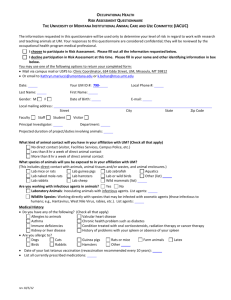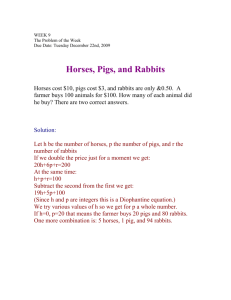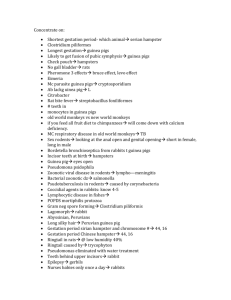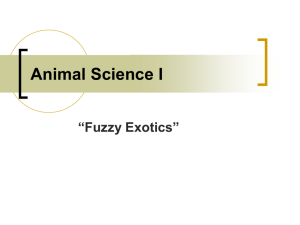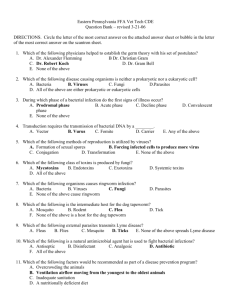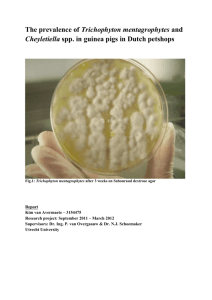HEMATOLOGY OF POCKET PETS
advertisement
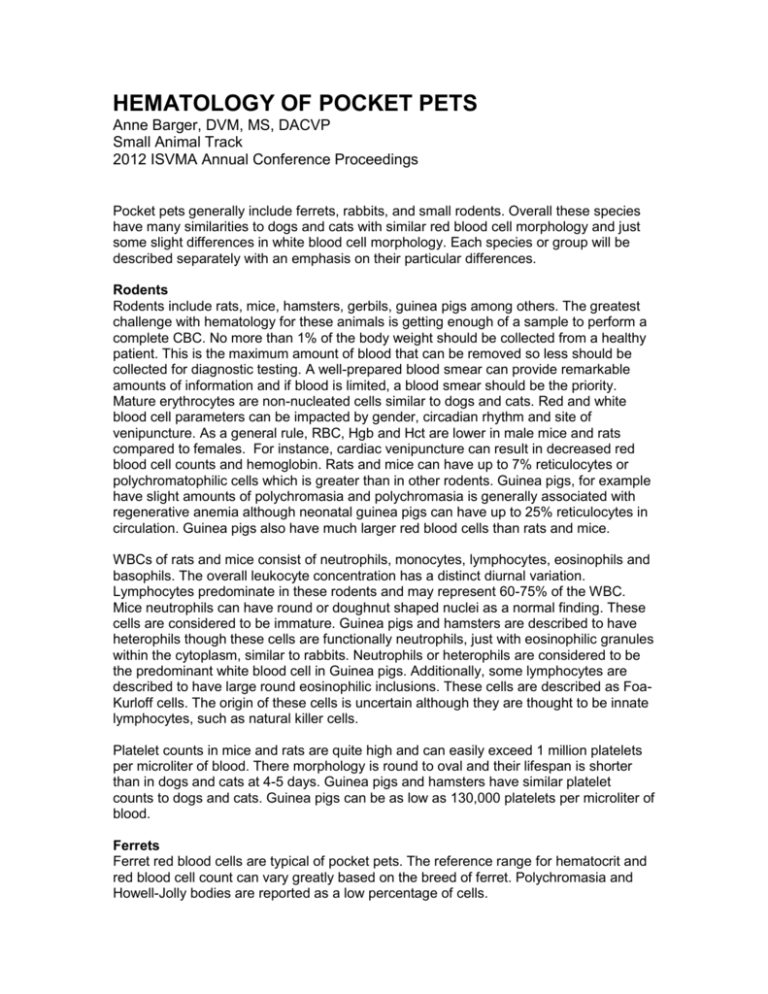
HEMATOLOGY OF POCKET PETS Anne Barger, DVM, MS, DACVP Small Animal Track 2012 ISVMA Annual Conference Proceedings Pocket pets generally include ferrets, rabbits, and small rodents. Overall these species have many similarities to dogs and cats with similar red blood cell morphology and just some slight differences in white blood cell morphology. Each species or group will be described separately with an emphasis on their particular differences. Rodents Rodents include rats, mice, hamsters, gerbils, guinea pigs among others. The greatest challenge with hematology for these animals is getting enough of a sample to perform a complete CBC. No more than 1% of the body weight should be collected from a healthy patient. This is the maximum amount of blood that can be removed so less should be collected for diagnostic testing. A well-prepared blood smear can provide remarkable amounts of information and if blood is limited, a blood smear should be the priority. Mature erythrocytes are non-nucleated cells similar to dogs and cats. Red and white blood cell parameters can be impacted by gender, circadian rhythm and site of venipuncture. As a general rule, RBC, Hgb and Hct are lower in male mice and rats compared to females. For instance, cardiac venipuncture can result in decreased red blood cell counts and hemoglobin. Rats and mice can have up to 7% reticulocytes or polychromatophilic cells which is greater than in other rodents. Guinea pigs, for example have slight amounts of polychromasia and polychromasia is generally associated with regenerative anemia although neonatal guinea pigs can have up to 25% reticulocytes in circulation. Guinea pigs also have much larger red blood cells than rats and mice. WBCs of rats and mice consist of neutrophils, monocytes, lymphocytes, eosinophils and basophils. The overall leukocyte concentration has a distinct diurnal variation. Lymphocytes predominate in these rodents and may represent 60-75% of the WBC. Mice neutrophils can have round or doughnut shaped nuclei as a normal finding. These cells are considered to be immature. Guinea pigs and hamsters are described to have heterophils though these cells are functionally neutrophils, just with eosinophilic granules within the cytoplasm, similar to rabbits. Neutrophils or heterophils are considered to be the predominant white blood cell in Guinea pigs. Additionally, some lymphocytes are described to have large round eosinophilic inclusions. These cells are described as FoaKurloff cells. The origin of these cells is uncertain although they are thought to be innate lymphocytes, such as natural killer cells. Platelet counts in mice and rats are quite high and can easily exceed 1 million platelets per microliter of blood. There morphology is round to oval and their lifespan is shorter than in dogs and cats at 4-5 days. Guinea pigs and hamsters have similar platelet counts to dogs and cats. Guinea pigs can be as low as 130,000 platelets per microliter of blood. Ferrets Ferret red blood cells are typical of pocket pets. The reference range for hematocrit and red blood cell count can vary greatly based on the breed of ferret. Polychromasia and Howell-Jolly bodies are reported as a low percentage of cells. The predominant leukocyte of a ferret is the neutrophil. Lymphocyte morphology is small but female ferrets can have slightly larger lymphocytes than male ferrets. Additionally, low numbers of large lymphocytes can be identified. Low numbers of eosinophils, basophils and monocytes are also observed. Platelet numbers are comparable to dogs and cats though the platelets are much smaller. During estrous, female ferrets can develop a significant thrombocytopenia. Rabbits Red blood cell morphology of rabbits can be quite variable. Marked anisocytosis can be seen in healthy, non-anemic rabbits. Rabbits can have up to 7% reticulocytes which can result in obvious polychromasia. The WBC is greatly impacted by age, breed and gender as well as nutritional status so care must be taken with interpretation. Similar to Guinea pigs, rabbit neutrophils are often referred to as heterophils due to the eosinophilic granulation. Rabbits will commonly have a mild lymphocyte lead. The lymphocyte morphology is primarily small and mature though large lymphocytes can be observed in circulation. Basophils can be seen with regularity and may represent 10-12% of the differential count.

